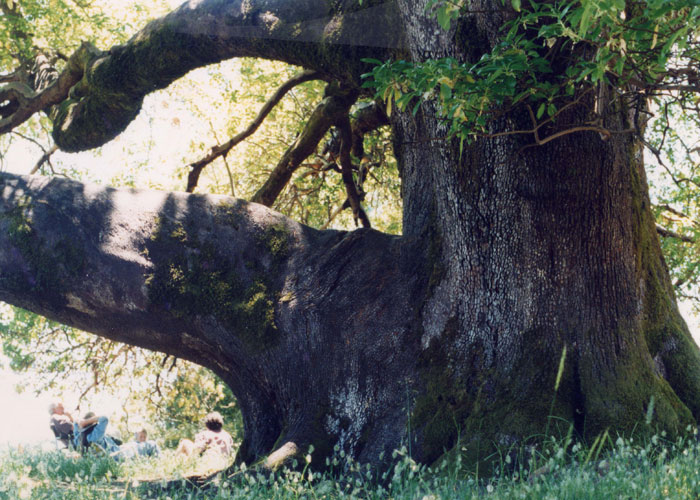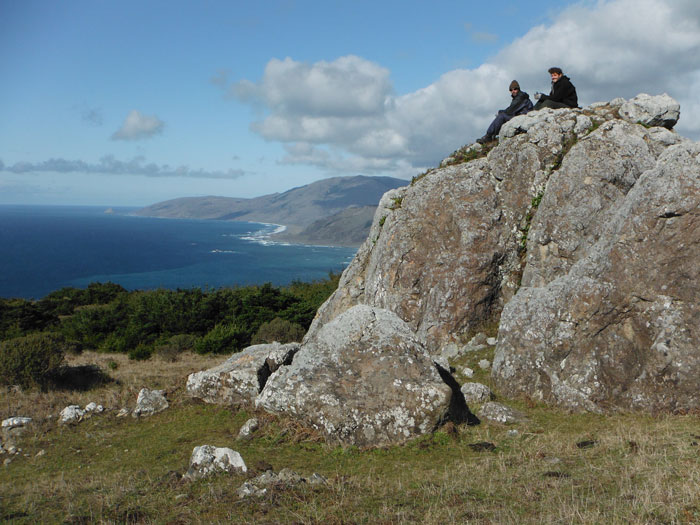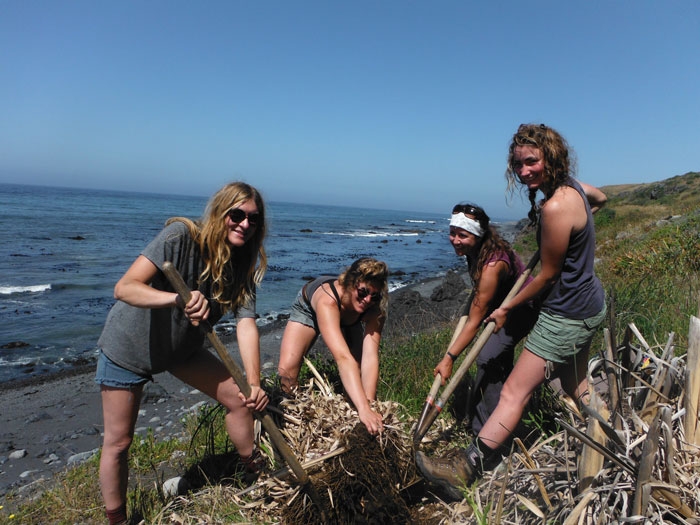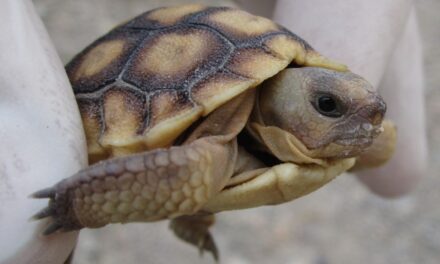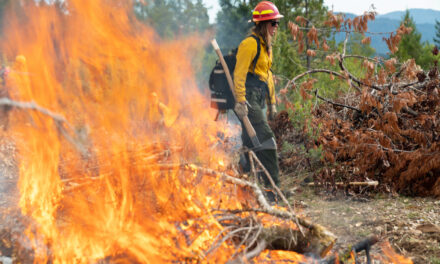- Death Valley’s Battle With Climate Extremes - 01/01/2024
- The Future of Homewood - 12/05/2023
- Kula Cloth - 10/18/2023
The Mattole Restoration Council: restoring the land from ridgeline to river
By Leonie Sherman
Deep in the forests of southern Humboldt lie the sprawling remains of the biggest madrone on the planet. Locals call it the Council Madrone. Indigenous people gathered beneath its branches for centuries. In 1983 an unlikely band of back-to-the-landers, ranchers and loggers sat in its shade and vowed to put aside their differences and work together to take care of the place they call home.
They realized that if they wanted to see healthy salmon runs they would need to replant hillsides barren after decades of abuse. They would need to stabilize riverbanks that had been scoured by catastrophic slides. If they wanted to avoid raging wildfire they would need to manage fuel reduction. They would need to think like a watershed.
The Mattole River begins in northern Mendocino County and flows north through Humboldt County before veering west and joining the ocean a few miles from Petrolia. One of the longest undammed, unaltered waterways in California, the Mattole drains about three hundred square miles of mixed forest, oak woodland and coastal prairie.
That band of Mattolians sitting under the Council Madrone formed the Mattole Restoration Council (MRC), one of the nation’s oldest community-led watershed groups. “We’ve found that the more we invest in putting plants and hillsides back in place, the more opportunity there is – for salmon, for forests, for employment,” says Executive Director Cassie Pinnell. “It’s a positive feedback loop.”
“Almost three quarters of the land in our watershed is privately owned,” Pinnell explains. “We’ve been building trust with landowners for decades, so we’re able to do comprehensive work across the watershed, wherever we identify a need. We’re building a bridge between public and private land owners.”
Sometimes they build actual bridges. Through their Good Roads, Clear Creeks program they’ve replaced culverts with fish-friendly crossings and removed hundreds of miles of unstable road bed. “In our early tree-planting days, we noticed seemingly endless old logging roads scarring our watershed,” explains Pinnell. “In a storm, water runs along poorly-engineered roads and creates a gully that transfers mud and silt straight into the river.”
“Everybody needs a working road to get to their property,” Pinnell continues. “Landowners let us put some roads on their property to rest in exchange for removing ruts and fixing holes on their access roads.” In the first eight years of the program, they kept 58,000 dump truck loads of sediment out of the river.
“Ask any watershed manager in California their biggest challenge and they’ll say water and fire,” says Ali Freedlund, Working Lands and Human Communities Program Coordinator. “Young trees suck a lot of water out of a system and create dense stands that are prone to fire. We offer projects that remove these younger fuels as well as a new timber harvest process known as the Mattole Program Timber Environmental Impact Report (PTEIR).”
A PTEIR stream-lines the process for timber harvest in exchange for adherence to stricter environmental regulations, like stream setbacks and a ban on cutting trees that were present before 1850. Because MRC does the heavy lifting of preparing the report, the application process is cheaper and quicker and loggers don’t need to remove as many trees to realize a profit.
Some of the young water-sucking trees encroach on rolling grasslands. “A native prairie can help combat fire,” Pinnell points out. “It’s an excellent sponge, storing water, which is really useful in times of drought.” So MRC removes trees and shrubs and replants grazed-over ranch land with native grasses.
“We collect and process seed and grow 30-50,000 plants a year,” explains Native Plant Nursery Manager, Monica Scholey. “Some of the bunch grasses we work with can live for a thousand years, so it’s kind of like old growth at our feet. We’ve transformed sites into complex perennial habitat with just sweat and hand tools!”
Scholey came to the MRC as an Americorps volunteer, fell in love with the land and decided to stay. Inspiring people to love their home is an integral part of watershed restoration. “We’re not just cultivating wild lands,” says Pinnell. “We’re cultivating the next generation of land stewards.”
In 2012 eight students from Humboldt State’s Environmental Science and Management Program stayed for a week. “They went back and raved about the importance of getting their hands in the dirt,” explains Mattole Field Institute Coordinator Flora Brain. “That led to a new partnership with Humboldt State’s Environment and Community Social Sciences Masters Program.”

MRC founding member, Richard Gienger, teaching MRC Mattole Field Institute students in 2015 (Flora Brain/MRC).
In August, MRC’s Field Institute hosted their first group of 11 graduate students. “We visited with cattle ranchers and land owners with big forest parcels. We talked about the social challenges in a remote rural watershed – timber harvest, marijuana cultivation and minimal opportunities for teens,” Brain says. “It really blew their minds. It also helped community members to articulate those issues and figure out how to move forward so we can preserve what we love.”
Nine years ago, Native Ecosystems Restoration Program Director Hugh McGee accepted a temporary position with MRC. He’d worked on projects all over the west, but the Mattole inspired him to stay. “Here, you design and implement a program, and when you go out to assess it, you realize you’re home.”
Brain hopes visitors will be inspired to take some of these lessons back to their own homes. “Really, the question we all need to be asking ourselves is: What can I do to give back to the places I love?”
Thinking Like a Salmon
Last winter the Mattole Salmon Group counted less than 2000 Chinook and only 14 Coho adult salmon between the mouth of the Mattole River and its headwaters, sixty miles away. “Lots of us believe that the salmon might be gone without our hatchbox program,” says Sungnome Madrone, Executive Director of the Mattole Salmon Group.
In the late 1970s, David Simpson and other Mattolians conceived an ambitious plan to bring back declining salmon numbers. They captured adult returning salmon, harvested their eggs and milt, and incubated the fertilized eggs in hatchboxes. These simple structures provided a secure place for eggs to develop and allowed young fish to escape back to the river; the egg-to-fry survival rate jumped from 15% to 80%.
“At first it was a big struggle to just convince agencies to let ordinary citizens handle fish,” explains Sungnome. “But now the National Marine Fisheries are supportive of our rearing programs and recent scientific studies show that the Mattole could have one of the highest possible success rates with a supplementation program.”
Federal protection of the Coho under the Endangered Species Act put a hold on any handling of the fish. “Now we focus on creating better habitat in the river and it’s tributaries,” Sungnome explains. “Mostly we do that by adding large wood to streams.” Water pours off the wood and scours out pools while also creating cover for fish to hide from predators.
Sungnome thinks that if salmon are to thrive, in the Mattole and elsewhere, we’ll need a massive cultural and economic shift. “Restoration is a legitimate industry and people ought to get paid to do it,” he says. “Isn’t it bizarre that you get paid a whole lot to destroy the environment, but the people who help clean up the mess are supposed to volunteer?”

